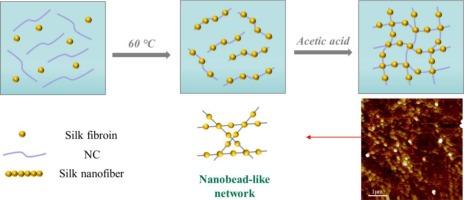通过多糖-蛋白质相互作用制备纳米纤维素-蚕丝纤维素硬水凝胶和高吸收低膨胀异凝胶
IF 10.7
1区 化学
Q1 CHEMISTRY, APPLIED
引用次数: 0
摘要
受多糖和蛋白质独特环境敏感性的启发,通过不同的诱导方法和组装顺序,开发出了具有定制网络结构和机械性能的纳米纤维素(NC)和蚕丝纤维素(SF)纳米复合水凝胶。在最佳工艺中,SF首先沿着NC模板组装,在热诱导下形成独特的纳米珠状结构,然后在醋酸凝固浴中交联,形成具有高机械强度的多糖-蛋白质纳米复合水凝胶,NC和SF的弹性模量分别为0.25 wt%和1.5 wt%,弹性模量高达62,330 G′(单位:Pa)。通过 TEMPO 介导的氧化作用将羧基引入 NC 并形成纳米珠状结构,提高了结构的稳定性,并显著增强了保水性。NC-SF 纳米复合水凝胶具有优异的机械性能,而衍生的 xerogels 具有出色的液体吸收性(高达 2300%)和保留性,在液体结合时体积膨胀极小(溶解比低于 5%)。这些特性使它们有望成为可生物降解的生物兼容材料,应用于卫生用品、尿布和止血基质等领域。本文章由计算机程序翻译,如有差异,请以英文原文为准。

Preparation of nanocellulose-silk fibroin stiff hydrogel and high absorbing-low expansion xerogel via polysaccharide-protein interactions
Inspired by the unique environmental sensitivities of polysaccharides and proteins, nanocellulose (NC) and silk fibroin (SF) nanocomposite hydrogels with tailored network structures and mechanical properties were developed by varying induction methods and assembly sequences. In the optimal process, SF was first assembled along the NC template to create a unique nanobead-like structure under thermal induction, followed by crosslinking in an acetic acid coagulation bath to form a polysaccharide-protein nanocomposite hydrogel with high mechanical strength, with elastic modulus as of 62,330 G′ in Pa at only 0.25 wt% NC and 1.5 wt% SF. The introduction of carboxyl groups to NC via TEMPO-mediated oxidation and the formation of nanobead-like structures improved structure stability and significantly enhanced water retention. The NC-SF nanocomposite hydrogels exhibited excellent mechanical properties, while the derived xerogels offered outstanding liquid absorption (up to 2300 %) and retention with minimal volume expansion upon liquid binding (dissolution ratio below 5 %). These properties make them promising candidates for biodegradable, biocompatible materials in applications such as sanitary products, diapers, and hemostatic matrices.
求助全文
通过发布文献求助,成功后即可免费获取论文全文。
去求助
来源期刊

Carbohydrate Polymers
化学-高分子科学
CiteScore
22.40
自引率
8.00%
发文量
1286
审稿时长
47 days
期刊介绍:
Carbohydrate Polymers stands as a prominent journal in the glycoscience field, dedicated to exploring and harnessing the potential of polysaccharides with applications spanning bioenergy, bioplastics, biomaterials, biorefining, chemistry, drug delivery, food, health, nanotechnology, packaging, paper, pharmaceuticals, medicine, oil recovery, textiles, tissue engineering, wood, and various aspects of glycoscience.
The journal emphasizes the central role of well-characterized carbohydrate polymers, highlighting their significance as the primary focus rather than a peripheral topic. Each paper must prominently feature at least one named carbohydrate polymer, evident in both citation and title, with a commitment to innovative research that advances scientific knowledge.
 求助内容:
求助内容: 应助结果提醒方式:
应助结果提醒方式:


